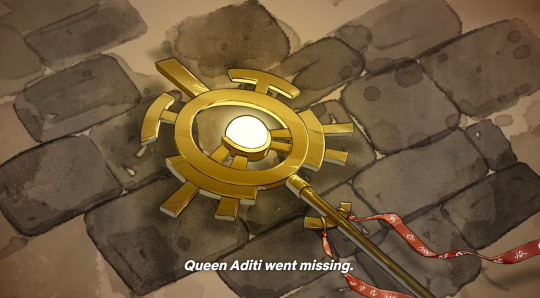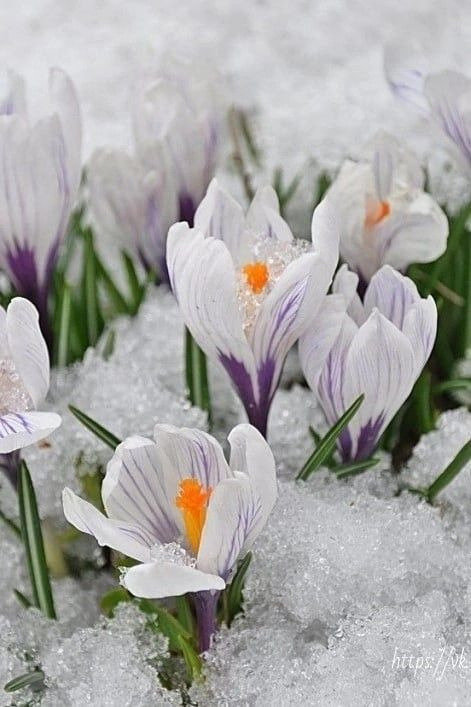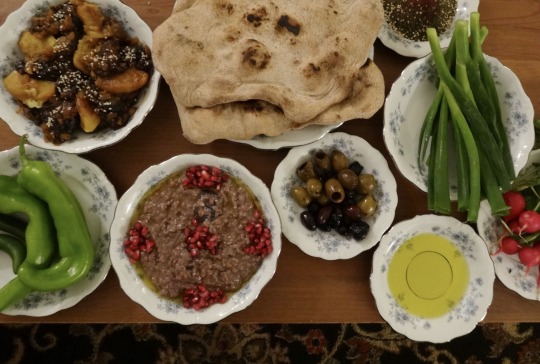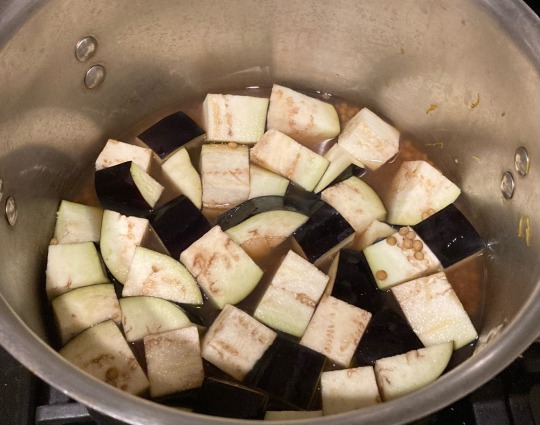#seasonal purification
Photo

Legends and myths about trees
Celtic beliefs in trees (11)
L for Luis (Rowan) - January 21st - February 17th
“Lady of the Mountains - Second month of the Celtic tree calendar”
Star: Sun; Gender: female; Gemstone: tourmaline; Patron: Brigantia, Brigid, St. Brigid; Symbols: living vigour + holy fervour, life force + spiritual power
Slender tree with smooth grey bark and graceful branches reaching towards the sky. In May, it produces an abundance of plump white flowers, which cluster together to form clusters the size of an adult palm. The flowers are very small, with five petals and sepals, and the ripe berries turn from green to red as autumn progresses. The rowan nut has a small pentagonal star shape on the opposite side of the base, and the pentagram has been known as a symbol of protection against evil since prehistoric times.
The rowan tree is dedicated to the ancient Britons' goddess Brigantia and the Irish goddess of liberal arts, Brigid who is associated with wisdom, poetry, healing, protection, blacksmithing and domesticated animals. Both Brigid and Brigantia have an aspect as patron goddesses of farmers and their livestock, promising the arrival of spring and a bountiful harvest. Together they are said to keep shooting flaming arrows made of rowan, which follow the sun all year round.
Since they are the goddesses who spin the thread and weave the cloth, it is they who continue to weave the everlasting fabric of life, guide the sun through the stars that occupy positions in the sky and keep the wheels of the seasons turning.
The Celtic festival of Imbolc takes place on 1 February and is dedicated to Brigid. This is because Brigid brings inspiration and visions to us and awakens the spirit of the year from its sleep. Imbolc is also the first 'Seasonal Purification Day' that comes around in the year, and on this day, the witches celebrate the Sabbath.
Rowan was once thought to be protected by this tree, as was the earth energy contained in ley lines (straight lines connecting ancient sacred sites and ruins) and menhirs (standing stones). Druids planted these trees at their ritual sites and used the smoke from burning rowan trees to invoke the spirits of the dead and warriors. The smoke from burning rowan trees was also often used to predict the course of a love affair.
For the Celts, the rowan was a symbol of nature's abode and vigorous life activity. Sacred, yet magically powerful, the rowan tree protects us from temptation and disease and was therefore discouraged from being cut down.

木にまつわる伝説・神話
ケルト人の樹木の信仰 (11)
L は Luis (ナナカマド) - 1月21日~2月17日
『山の淑女〜ケルトの木の暦の第2月』
星: 太陽、性: 女性; 宝石: トルマリン、守護神: ブリガンティア、ブリギッド、聖ブリギッド、シンボル: 生きる活力+聖なる熱情、生命力+霊力
なめらかな灰色の樹皮をもつ、すらりと細身の木で、優美な枝が天にむかって伸びている。5月になると白くふっくらとした花をふんだんに咲かせ、それらが群がって大人の手のひらほどの房を作る。花はとても小さく、5弁の花びらと萼ををもち、秋が深まるにつれ、熟した実は緑色から赤色に変色する。ナナカマドの実には柄の反対側に小さな五角形の星型がついているが、5線星型は太古の時代から魔除けのシンボルとして知られている。
ナナカマドの木は、古代ブリトン人たちの女神ブリガンティアや、アイルランドの学芸をつかさどる女神ブリギッドに捧げられている。彼女は知恵、詩、癒し、保護、鍛冶、家畜と関連している。ブリギッドもブリガンティアも、農牧の民とその家畜を守護する女神としての一面を持ち、春の到来を約束し、豊かな収穫をもたらすとされている。この二人は共にナナカマドでできた燃える矢を放ちつづけ、その矢は太陽の後を一年中追い続けるといわれている。糸を紡ぎ、布を織る女神であることから、とこしえに続く生命の布を織りつづけ、天空に位置を占める星の間を縫って太陽を導き、季節の歯車を回し続けるのもこの二人である。
ケルト人の祭りであるインボルクは2月1日に行われ、ブリギッドに捧げられる。ブリギッドが霊感や幻視を私たちにもたらし、一年の精霊を眠りから覚ましてくれるからである。インボルクは一年で最初にめぐってくる「季節祓いの日」にも当たり、この日、魔女たちはサバトを祝う。
かつてレイライン (古代の聖地や遺跡を結ぶ直線)やメンヒル (立石) に含まれる大地のエネルギーは、ナナカマドに守られていると信じられていた。ドルイドたちは祭壇の場にこの木を植え、ナナカマドを燃やした煙で死者の霊や戦士を呼び出していた。ナナカマドを燃やした煙はまた恋の行方を占う際にもよく使われた。
ケルト人にとって、ナナカマドは、自然が宿すシンボルであり、旺盛な生命活動の象徴でもあった。神聖で、しかも魔法の力をもつナナカマドは、誘惑や病気から私たちを守ってくれるので、伐採は慎むべきとされていた。
#trees#rowan#celtic tree calendar#celtic belief#tree legend#tree myth#mythology#lgends#brigid#brigantia#celtic goddess#lady of the mountains#sacred tree#protection#imbolc#seasonal purification#nature#art
229 notes
·
View notes
Text
The Sun Staff, Sunforge and Dark Magic purification.

Sunfire elves play a pivotal role in the history of Xadia. They have the largest, most centralised civilisation and Queen Aditi was trusted with deciding the next Archdragon Monarch after the fall of Luna Tenebris.


Assuming he’s responsible for her disappearance, is this why Aaravos targeted her?
Or… was there more at play?
Were the abilities of healing and purification associated with Sun magic an issue for his overarching plan?
Aaravos targets mages, tempting them with hidden knowledge. It’s not stated that he’s targets human mages exclusively and he seemed to bring chaos to the entire continent indiscriminately.
(Considering where we last saw Karim, I am concerned for him…)


Still, the implication seems to be, in order for a mage to fall under his control, they need to have used Dark Magic.
Even a single time.
Which got me thinking… would Viren have been “free” of corruption and therefore immune to Aaravos direct control had he been purified (and survived).


What does this imply for Callum?
Is it possible to purify the corrupted Sun Staff and recover the Sunforge? Can these be used to purge mages of Dark Magic corruption? (Is Claudia at risk of also being controlled if she “rebels”?)

Just how vulnerable to Aaravos direct control is Callum? Are we going to see another Dark Magic coma revelation for him, allowing him to resist Aaravos control and another path? Or is he literally a ticking time bomb?
#have I already been planning some stuff with Sun magic and purification in some of my fics….?#maaaaaaaaaybe#the dragon prince#tdp#callum#aaravos#viren#tdp spoilers#tdp season 4 spoilers#also did i put in a large image of Rayla when I absolutely didn’t have to#yes#yes I did
527 notes
·
View notes
Text

pov you’re still mad about the Killing Eve finale for the exact opposite reason as everybody else
#this has been sitting in my laptop for months but every time i remember it it makes me laugh so#here#they were SUPPOSED to die in each others arms drenched in blood!!!!#the finale was the best episode of the season and they still didn't quite get it#but eve lives bc its a rebirth and a purification! that's dumb as shit and contrary to the entire point#bonking laura neal on the head with a flyswatter#killing eve#killing eve 4.08#villaneve#eve polastri
217 notes
·
View notes
Text
soothing my aching soul by world building a humanist solarpunk society that’s like a star trek federation commie fever dream
#holidays are frequent and meaningful but not tied to religion#tied to the seasons and community and humanity#holidays are mostly about building and renewing community ties observing the passage of time celebrating life#some holidays are somber#a day of rememberance and a day of forgiveness#both of which have rituals of purification/absolution#using my anthro degree to build a fantasy society where all of our needs are acknowledged
8 notes
·
View notes
Text
The Spiritual Significance of the First Monday of Sawan Month in Hinduism
Introduction
In Hinduism, the month of Sawan (also known as Shravan) holds immense spiritual significance. It is a time when devotees of Lord Shiva engage in intense religious observances and worship to seek his blessings. Among the various days of Sawan, the first Monday, known as “Shravan Somvar” or “Sawan Somvar,” stands out as an auspicious occasion. This day is believed to hold special…

View On WordPress
#Blessings#Devotion#Divine Grace#Hinduism#Kanwar Yatra#Lord Shiva#monsoon season#Purification#Religious Observances#Rituals#Sacred Practices#Sawan Somvar#Shravan Month#spiritual growth#Spiritual Significance
2 notes
·
View notes
Text

Rainy seasons refresh the environment and provide respite from the sweltering heat. Still, they have their share of difficulties, particularly regarding drinking water quality. Due to polluted water sources, waterborne illnesses are more common during the monsoon season. Here, RO purifier services are essential for guaranteeing the purity and safety of drinking water.
Do Read: https://ramservicesandsales.com/2023/08/21/rainy-season-ro-purifier-service-ensuring-safe-and-clean-drinking-water/
#best doorstep RO services in Nagpur#Best RO services in Nagpur#Best RO Water Purifier Repair in Nagpur#Effective RO Purifier Maintenance#Expert RO Purifier Service Provider#Monsoon RO Purifier Care#Monsoon RO Water Filter Replacement#Monsoon RO Water Purifier Maintenance#Preventive RO Purifier Maintenance#Professional RO Purifier Service#Rainy Season RO Filter Cleaning#Rainy Season RO Purifier Cleaning#Rainy Season RO Purifier Service#Rainy Season RO System Check#Rainy Season Water Filter Servicing#Rainy Season Water Purification Service#Regular RO Purifier Checkup#Reliable RO Purifier Maintenance#RO Purifier Cleaning and Maintenance#RO Purifier Filter Replacement#RO Purifier Service#RO Purifier Technician#RO System Servicing#RO Water Filter Repair#RO Water Purification Service#Seasonal RO Purifier Checkup#Specialized Monsoon RO Service#Water Purifier Maintenance#Water Purifier Repair in Nagpur#Water Purifier Service Center Nagpur
1 note
·
View note
Text
Spring Equinox Masterpost- Spoonie Witch Friendly

Art Credit: Anastasia Catris
The Spring Equinox, also called the Vernal Equinox or Ostara, is usually celebrated between the 21st of March in the Northern Hemisphere (In the Southern Hemisphere around September 20th or 21st)
In 2024, Ostara and the Spring Equinox land in the Northern Hemisphere on Monday, March 19th.
The Spring Equinox celebrates the arrival of spring. Celebrating balance, growth, and new beginnings as Winter has finally ended.
Spring Equinox Correspondances
Colours
Light Green
Lavender
Sunny Yellow
Light Blue
Pastel Pink
White
Herbal
Lemongrass
Daffodils
Tulips
Violets
Apple Tree
Cherry Blossom
Primrose
Birch tree
Hyacinths
Dandelion
Garlic
Ash tree
Jasmine
Edibles
Honey
Salad greens
Spring veggies
Fresh berries
Mead
Herbs
Eggs
Seeds
Bread
Edible flowers
Quiches
Custards
Maple
Animals
Hares
Baby Chicks
Snakes
Robins
Bees
Butterflies
Phoenix
Ram
Crystals
Fluorite
Moonstone
Silver
Aquamarine
Clear Quartz
Amazonite
Symbols
Bonfires
Flowers
Rabbits
Eggs
Seeds
Baskets
Flowering or Tree Buds
Lambs
Birds
Spiritual meanings
Purification
Cleansing (removal of stagnant energy)
Growth
Transition
Motivation
Balance
Birth
Good fortune
Kindness
Joy
Fertility
Scents
Coconut
Citrus
Floral scents (rose, lilac, jasmine, etc)
Herbal scents (rosemary, basil, mint, etc)
Gods / Goddesses / Spirits
Eostre – (Anglo-Saxon)
Aphrodite - (Greek)
Gaia - (Celtic)
Gaea - (Greek)
Venus - (Roman)
Athena - (Greek)
Aurora - (Roman)
Eos - (Greek)
Isis – (Egyptian)
Freya - (Norse)
Persephone - (greek)
Cybele - (Roman)
The Green Man - (Celtic)
Odin – (Norse)
Osiris – (Egyptian)
Pan – (Greek)
Thoth – (Egyptian)
Adonis – (Greek)
Apollon – (Greek)
Apollo - (Roman)
Need some suggestions to celebrate? I've got you covered.
High energy celebrations and ritual
Deep cleaning of the hearth and home
Nature hikes
Visiting farmers markets
Making preserves
Create a fae garden
Create a seasonal altar
Abundance/Prosperity ritual
New beginnings ritual
Low energy celebrations
Wear pastels
Create flower crowns
Light a candle with scent correspondence
No spoon celebrations
Opening a window
Journaling Prompts
Keeping hydrated
Drink floral tea
Rest
How you celebrate the holiday does not matter. You can choose to do any activity that feels right. These are only suggestions and remember that you're enough no matter what.
Also please note some stuff is UPG. A great book is Year of the Witch by Temperance Alden for honouring the celebrations and if you wanted to work more seasonally. It's not Wiccan-based and has plenty of resources for every witch.
Feel free to post how you celebrate in the comments or reblogs!
Want to see more of my posts? Check out my Wheel of the Year Masterpost or my Main Masterpost.
#witchcraft#witch#electic witch#witchblr#paganism#spoonie witch#spoonie magic#ostara#wheel of the year#witchy#spring equinox#seasonal magic#ostara masterpost#ostara correspondences#spring equinox masterpost#spring equinox correspondances#spoonie#chronic illness magic#chronic illness
944 notes
·
View notes
Link
0 notes
Text









Imbolc "In the belly" (Feb 1-2) 🐑
Midway point between the winter solstice and spring equinox,
Winter is slowly but surely coming to an end and spring is just around the corner. The days are getting longer and snowdrops, crocus and daffodils are starting to bloom.
Farmers sow the first seeds, sheep are lactating and the first lambs are born.
Imbolc is all about purification, fertility and rebirth.
Correspondences for Imbolc:
Symbols; lambs, Brigid cross, candles, sun, fire, seeds, milk, spring flowers.
Colors; white, pastels (green, yellow), earth tones, gold.
Spells; Cleansing, gratitude, rebirth/renewal.
Crystals; amethyst, quartz, aventurine, selenite, moonstone.
Flowers and herbs; lavender, rosemary, cinnamon, bay leaf, chamomile.
Food; pancakes, milk, soups, seasonal vegetables, seeds, cheese, yogurt, poppyseeds, homemade bread, cakes, dried fruits, teas.
Imbolc activities; cleaning, planning your garden, planting the first seeds, nature walk, lightning candles, bake bread, make a Brigid cross, write poems, make art.
#whimsigothic#whimsigoth#whimsical#whimsigoth room#whimsigothcore#whimsigothaesthetic#witchy aesthetic#witches#witchy#witchyvibes#witch#witchcraft#witchythings#witchcore#witch aesthetic#witch blog#whimsical aesthetic#aesthetic#whimsigoth style#witchy vibes#winter solstice#wheel of the year#sabbats#imbolc#pagan#bridgid cross#maslenitsa#slavic
1K notes
·
View notes
Text
Imbolc Altar Ideas & Correspondences

Imbolc, also known as Candlemas or Brigid's Day, marks the halfway point between the winter solstice and the spring equinox. It's a time to celebrate the returning light and the awakening of the Earth.
Altar Decorations:
Candles: Imbolc is strongly associated with the element of fire. Decorate your altar with candles in shades of white, yellow, and light blue to represent the increasing daylight.
Brigid's Cross: Craft or purchase a Brigid's Cross, a traditional symbol associated with the Celtic goddess Brigid. Hang it on your altar as a protective charm.
Seasonal Flowers: Place early spring flowers like snowdrops, crocuses, and daffodils on your altar. These symbolize the first signs of life returning to the land.
Herbs: Incorporate herbs such as rosemary, thyme, and cinnamon for their purifying and invigorating properties. Bundle them together with a red or white ribbon.
Seeds: Represent the potential for growth by adding a dish of seeds to your altar. Consider seeds associated with early spring crops like wheat or herbs.
Imbolc Symbols: Include symbols like lambs, ewes, and the sun to capture the essence of this seasonal transition.
Candle Holders: Choose unique candle holders or lanterns to enhance the ambiance. Consider using candle holders in the shape of suns, stars, or nature-inspired designs.
Divination Tools: Add divination tools like tarot cards or runes to your altar for seeking guidance during this transitional period.
Symbolic Stones: Integrate crystals such as citrine for abundance, aquamarine for clarity, and moonstone for intuition. Arrange them aesthetically around your altar.
Feathers: Symbolizing air and spirituality, feathers can be incorporated to invoke the energy of the season. Choose feathers from birds associated with the goddess Brigid, like swans or owls.
Artwork: Display artwork or illustrations that resonate with the themes of Imbolc. This could include depictions of Brigid, snow-covered landscapes, or symbols of growth and renewal.
Imbolc Incense: Craft or purchase incense blends with scents like frankincense, myrrh, and chamomile to fill your sacred space with a soothing and purifying aroma.
Correspondences
Goddess Brigid: Imbolc is sacred to Brigid, the Celtic goddess of hearth, home, and inspiration. Invoke her energy for healing, creativity, and protection.
Colors: White, yellow, light green, and light blue are associated with Imbolc. Use these colors in candles, altar cloths, and decorations to align with the festival's energy.
Stones: Crystals such as amethyst, garnet, and clear quartz resonate with Imbolc's energies.
Foods: Dairy products, especially cheese, and foods made with seeds like bread or muffins are fitting for Imbolc. Set offerings on your altar or incorporate them into your celebration feast.
Water: Imbolc is also associated with the element of water. Include a small bowl of water on your altar to symbolize purification.
Creativity Symbols: Imbolc is a time for inspiration and creative endeavors. Include symbols of your creative pursuits, such as a paintbrush, musical instrument, or writing quill.
Anointing Oils: Create or purchase anointing oils infused with herbs like lavender, rosemary, and frankincense. Use them to anoint candles, tools, or yourself during Imbolc rituals.
Animal Representations: Incorporate figurines or images of animals associated with Brigid, such as lambs, cows, or swans, to honor her connection to the animal kingdom.
Wheat or Corn Dolls: Craft small dolls from wheat or corn husks, symbolizing the harvest to come. Place them on your altar as a representation of the Earth's fertility.
Bell or Chimes: Hang a bell or wind chimes near your altar to symbolize the awakening of nature and the stirring of life. Ring it during your Imbolc rituals to mark significant moments.
Decorative Cloth: Choose an altar cloth with intricate patterns or symbols related to Imbolc, such as suns, wheels, or Brigid's crosses, to add a touch of magic to your sacred space.
May you find warmth in the returning light. <3
#pagan#witchcraft#paganism#witch#occult#wicca#dark#magick#neopagan#wiccan#imbolc#february#witchblr#imbolg#brigid of kildare#goddess brigid#st brigid
668 notes
·
View notes
Text
#The Acne / Backne Pack by Bare Beauty Naturals addresses the 3 pathways to acne treatment: Strong makeup removal soap#exfoliating soaps#detox & pore purification soaps#radiant skin toning soaps and acne bacteria eliminators.#Find what works for you with travel sizes of our seasonally selected acne fighting line#then focus on the products that work best for you!#You will receive*:#✔African Black Soap#✔Activated Charcoal Deep Cleaning Detox Soap#✔Radiant Aloe Skin Renewing Soap#✔Antifungal Soap#✔Arnica Poppymint exfoliating soap#✔Honeysuckle Tea Tree Soap#✔1 large Baby Burlap skin exfoliating soap bag#✔5 small muslin exfoliating soap bags#Purchase online at https://www.barebeautynaturals.com or check the link on our Instagram Bio!#barebeautynaturals#allnatural#africanblacksoap#acnepack#backnepack#activatedcharcoal#radiantaloe#antifungalsoap#arnicapoppymint#honeysuckletea#teatreesoap#babyburlap#muslinexfoliatingsoapbags#bbn
0 notes
Text


[ID: A purplish-grey stew topped with olive oil and garnished with piles of pomegranate seeds. Plates of green peppers, bitter olives, olive oil, taboon bread, green onions, radishes, and za'tar surround the dish. The second image is a close-up of the same stew. End ID]
رمانية / Rummāniyya (Palestinian pomegranate stew)
Rummaniyya (رُمَّانِيَّة; also transliterated "rumaniyya," "rummaniya," and "rummaniyeh") is a Palestinian stew or dip made from lentils, eggplant, and pomegranate seeds, flavored with nutty red tahina and a zesty, spicy دُقَّة (dugga) of dill seeds, garlic, and peppers. A طشة (ṭsha), or tempering, of olive oil and onion or garlic is sometimes added.
"Rummaniyya," roughly "pomegranate-y," comes from رُمَّان ("rummān") "pomegranate," plus the abstract noun suffix ـِيَّة ("iyya"); the dish is also known as حبّة رُمَّانَة ("ḥabbat rommāna"), or "pomegranate seeds." It is a seasonal dish that is made at the end of summer and the beginning of fall, when pomegranates are still green, unripe, and sour.
This stew is considered to be one of the most iconic, historic, and beloved of Palestinian dishes by people from Gaza, Yaffa, and Al-Ludd. Pomegranates—their seeds, their juice, and a thick syrup made from reducing the juice down—are integral to Palestinian cuisine and heritage, and images of them abound on ceramics and textiles. Pomegranates and their juice are sold from street carts and cafes in the West Bank and Gaza.
Today, tens of thousands of tons of pomegranates are grown and harvested by Israeli farmers on stolen Palestinian farmland; about half of the crop is exported, mainly to Europe. Meanwhile, Palestinians have a far easier time gaining permits to work on Israeli-owned farms than getting permission from the military to work land that is ostensibly theirs. These restrictions apply within several kilometers of Israel's claimed borders with Gaza and the West Bank, some of the most fertile land in the area; Palestinian farmers working in this zone risk being injured or killed by military fire.
Israel further restricts Palestinians' ability to work their farms and export crops by imposing tariffs, unexpectedly closing borders, shutting down and contaminating water supplies, spraying Palestinian crops with pesticides, bulldozing crops (including eggplant) when they are ready to be harvested, and bombing Palestinian farmland and generators. Though Palestinian goods have local markets, the sale of Palestinian crops to Israel was forbidden from 2007 to 2014 (when Israel accepted shipments of goods including tomato and eggplant).
Gazans have resisted these methods by disregarding orders to avoid the arable land near Israel's claimed borders, continuing to forage native plants, growing new spices and herbs for export, planting hydroponic rooftop gardens, crushing chalk and dried eggplants to produce calcium for plants, using fish excrement as fertilizer, creating water purification systems, and growing plants in saltwater. Resisting Israeli targeting of Palestinian food self-sufficiency has been necessary for practical and economic reasons, but also symbolizes the endurance of Palestinian culture, history, and identity.
Support Palestinian resistance by calling Elbit System's (Israel's primary weapons manufacturer) landlord; donating to Palestine Action's bail fund; and buying an e-Sim for distribution in Gaza.
Serves 6-8.
Ingredients:
For the stew:
1 medium eggplant (370g)
1 cup brown lentils (عدس اسود)
600g pomegranate seeds (to make 3 cups juice)
3 Tbsp all-purpose flour
1/4 cup red tahina
1/2 cup olive oil
Salt, to taste
Citric acid (ملح الليمون / حامِض ليمون) (optional)
Red tahina may be approximated with home cooking tools with the above-linked recipe; you may also toast white tahina in a skillet with a little olive oil, stirring often, until it becomes deeply golden brown.
For the دُقَّة (dugga / crushed condiment):
2 tsp cumin seeds, or ground cumin
1 1/2 Tbsp dill seeds ("locust eye" بذور الشبت / عين جرادة)
5 cloves garlic
1 green sweet pepper (فلفل بارد اخضر)
2 dried red chilis (فلفل شطة احمر)
People use red and green sweet and chili peppers in whatever combination they have on hand for this recipe; e.g. red and green chilis, just green chilis, just red chilis, or just green sweet peppers. Green sweet peppers and red chilis are the most common combination.
For the طشة (Tsha / tempering) (optional):
Olive oil
1 Tbsp minced garlic
Instructions:
1. Rinse and pick over lentils. In a large pot, simmer lentils, covered, in enough water to cover for about 8 minutes, or until half-tender.
2. Meanwhile, make the dugga by combining all ingredients in a mortar and pestle or food processor, and grinding until a coarse mixture forms.

Dugga and components.
3. Cube eggplant. A medium-sized eggplant may be cut in half lengthwise (through the root), each half cut into thirds lengthwise, then cubed widthwise.


Cubed eggplant, red tahina, and pomegranate seeds.
4. Add eggplant to simmering water (there is no need to stir).

5. While the eggplant cooks, blend pomegranate seeds in a blender very thoroughly. Strain to remove any gritty residue. Whisk flour into pomegranate juice.

Pomegranate juice being strained.
6. Taste your pomegranate juice. If it is not sour, add a pinch of citric acid or a splash of lemon juice and stir.
7. Add dagga to the pot with the lentils and eggplant and stir. Continue to simmer until the eggplant is very tender and falling apart.
8. Add pomegranate juice, tahina, and olive oil to the pot, and simmer for another 5 minutes, or until stew is very thick and homogenous.

Bright pink pomegranate juice in stockpot.
9. (Optional) In a small skillet, heat a little olive oil on medium. Fry minced garlic, stirring constantly, until golden brown. Add into the pot and stir.
10. (Optional) Mash the stew with the bowl of a ladle or a bean masher to produce a more homogenous texture.
Serve rummaniyya hot or cold in individual serving bowls. It may be served as an appetizer, or as a main dish alongside flatbread, olives, and fresh vegetables such as radishes, green peppers, green onions, carrots, and romaine lettuce. It may be eaten with a spoon, or by using كماج (kmāj), a flatbread with an internal pocket, to scoop up each bite.
559 notes
·
View notes
Text
February 2024 witch guide
Full moon: February 24th
New moon: February 9th
Sabbats: Imbolc-February 1st
February Snow Moon
Known as: Eagle Moon, Horning Moon, Solmonath Moon, Bear moon, Ice Moon, Wild Moon, Raccoon Moon, Big Winter Moon, Groundhog Moon, Quickening Moon, Storm Moon, Goose Moon, Hungry Moon & Red/Cleansing Moon
Element: Fire
Zodiac: Aquarius & Pisces
Nature spirits: House Faeries
Deities: Aphrodite, Brigid & Nut
Animals: Otter & Unicorn
Birds: Chickadee & Eagle
Trees: Cedar, laurel, myrtle & rowan
Herbs: Balm of Gilead, hyssop, myrrh, sage & spikenard
Flowers: Primrose
Scents: Heliotrope & wisteria
Stones: Amethyst, jasper, moonstone, obsidian, onyx , rose quartz, topaz & red zircon
Colors: Light blue & violet
Energy: Astral travel, banishing, beginnings, breaking bad habits, creativity expressiveness, empowerment, energy working to the surface, fertility, forgiveness, freedom, friendships, future plans, growth, healing, problem solving, purification, responsibility & science
February’s full Moon is a “Micromoon” this year. Think of this term as the opposite of a “Supermoon.” It simply means that the full Moon is at its farthest point from Earth (not the nearest point).
The explanation behind February’s full Moon name is a fairly straightforward one: it’s known as the Snow Moon due to the typically heavy snowfall that occurs in February. On average, February is the United States’ snowiest month, according to data from the National Weather Service. In the 1760s, Captain Jonathan Carver, who had visited with the Naudowessie(Dakota), wrote that the name used for this period was the Snow Moon, “because more snow commonly falls during this month than any other in the winter.”
Imbolc
Known as: Feast of Torches, Feast of Waxing Light, Oimele & Brigid's Day
Season: Winter
Symbols: Besoms, Brighid's crosses, candles, candle wheels, fertility symbols, fire, ploughs, priapic wands & white flowers
Colors: Black, brown, Earth tones, lavender, light green, orange, pink, red, white & yellow
Oils/Incense: Apricot, basil, bay, carnation, chamomile, cinnamon, dragon's blood, frankincense, heather, jasmine, myrrh, neroli, red sandalwood, sage, vanilla, violet & wisteria
Animals: Badger, cow, deer,groudhog, robin, sheep, snake, & swan
Mythical: Dragon
Stones: Amethyst, bloodstone, citrine, clear quartz, garnet, green tourmaline, hematite, iron, lodestone, onyx, red zircon, rose quartz, ruby, turquoise, yellow tourmaline
Food: Breads, chives, curries, dairy products, grains, garlic, herbal teas, honey cakes, lamb, muffins, onions, peppers, poppy seed cakes, pork, poultry, pumpkin seeds, raisins, scones, spiced wines & sunflower seeeds
Herbs/Plants: Angelica, ashleaf, balsam, basil, bay laurel, benzoin, blackberry, clover, coltsfoot, coriander, dragon's blood, garlic, heather, lemon, myrrh, rosemary, sage, vervain, wheat & witch hazel
Flowers: Celandine, chamomile, iris, rose hips, snowdrop, sunflower, tansy, violets, white flowers & yellow flowers
Goddesses: Anu, Aradia, Arianrhod, Artio, Athena, Branwen, Brigid, Danu, Februa, Gaia, Inanna, Juno, Selene, Sirona & Vesta
Gods: Aegus Mac Og, Bragi, Cupid, Dian Cecht, Dumuzi, Eros, Februus & Pax
Issues, Intentions & Powers: Activation/awakening, animals, beginnings, fertility, healing, hope, illumination, inspiration, light, pregnancy/childbirth, prophecy, transformation, well-being & youth
Spellwork: Air magick, banishings, candle spells, divination, fertility spells, prosperity & purification
Activities:
• Make & light white candles
• Clean/decorate your altar & consecrate your altar tools
• Go on a walk in nature & look for signs of spring
• Make a Brigid's Cross
• Have a feast with your family/friends
• Give thanks & leave offerings to the Earth
• Set intentions, reflect & look deeper into your goals for spring
• Start a bonfire
• Find Imboloc prayers & devotionals that bid farewell to the winter months, honor the goddess Brigid, as well as seasonal blessings for your meals, hearth, & home.
• Pepare plans for your upcoming garden
• Craft a priapic wand
• Spend time with children celebrating Imbolc by making crafts & or baking
• Practice divination & fire scrying
• Draw a cleansing ritual bath for yourself
• Meditate, reflect & say your farewells to winter
• Cleanse & clean your house to prepare for spring
• Create a Brídeóg: a doll of Brigid made of straw
• Make Bride's bouquet satchets & exchange as symbols of good luck and fertility
• Set aside food & or drinks as an offering to Brigid to invite her in your home
Imbolc is a Gaelic festival marking the beginning of spring. Most commonly it is held on January 31 – February 1, or halfway between the winter solstice & the spring equinox. The holiday is a festival of the hearth, home, a celebration of the lengthening days & the early signs of spring.
The word "imbolc" means "in the belly" and refers to the pregnancy of ewes at this time of year. The term "oimelc" means ewe's milk. Around this time of year, many herd animals give birth to their first offspring of the year or are heavily pregnant & as a result, they are producing milk. This creation of life’s milk is a part of the symbolic hope for spring.
Imbolc is mentioned in some of the earliest Irish literature and it is associated with important events in Irish mythology. It has been suggested that it was originally a pagan festival associated with the goddess Brigid and that it was Christianized as a festival of Saint Brigid, who herself is thought to be a Christianization of the goddess.
Some use Imbolc to celebrate the longer days which herald the return of Spring & The Goddess's recovery from giving birth to The Sun (The God) at Yule. The God & The Goddess are children symbolizing new life, new beginnings & new resurrections.
Related festivals:
• Groundhog Day- Is a tradition observed in the United States & Canada on February 2 of every year. It derives from the Pennsylvania Dutch superstition that if a groundhog emerges from its burrow on this day & sees its shadow, it will retreat to its den & winter will go on for six more weeks; if it does not see its shadow, spring will arrive early.
While the tradition remains popular in the 21st century, studies have found no consistent association between a groundhog seeing its shadow & the subsequent arrival time of spring-like weather.
•St. Brigid's Day- 1 February. It was originally Imbolc, the first day of spring in Irish tradition. Because Saint Brigid has been theorised as linked to the goddess Brigid, some associate the festival of Imbolc with the goddess. St. Brigid is the patroness saint (or 'mother saint') of Ireland. She is patroness of many things, including poetry, learning, healing, protection, blacksmithing, livestock & dairy production. In her honour, a perpetual fire was kept burning at Kildare for centuries.
A recent campaign successfully established her feast day as a national holiday in 2023.
• Chinese New Year- (February 10th) the festival that celebrates the beginning of a new year on the traditional lunisolar Chinese calendar. In Chinese, the festival is commonly referred to as the Spring Festival,- marking the end of winter and the beginning of the spring season. Observances traditionally take place from Chinese New Year's Eve, the evening preceding the first day of the year, to the Lantern Festival, held on the 15th day of the year. The first day of Chinese New Year begins on the new moon that appears between January 21st & February 20th.
The Chinese New Year is associated with several myths and customs. The festival was traditionally a time to honour deities as well as ancestors. Within China, regional customs and traditions concerning the celebration of the New Year vary widely & the evening preceding the New Year's Day is frequently regarded as an occasion for Chinese families to gather for the annual reunion dinner.
It is also a tradition for every family to thoroughly clean their house, in order to sweep away any ill fortune & to make way for incoming good luck. Another custom is the decoration of windows & doors with red paper-cuts and couplets. Popular themes among these paper-cuts and couplets include good fortune or happiness, wealth & longevity. Other activities include lighting firecrackers & giving money in red envelopes.
• Candlemas- is a Christian feast day on February 2nd commemorating the presentation of Jesus at the Temple. It is based upon the account of the presentation of Jesus in Luke 2:22-40.
While it is customary for Christians in some countries to remove their Christmas decorations on Twelfth Night, those in other Christian countries historically remove them after Candlemas.On Candlemas, many Christians also take their candles to their local church, where they are blessed and then used for the rest of the year.
•Setsubun- (February 3rd) Is the day before the beginning of spring in the old calendar in Japan. The name literally means 'seasonal division', referring to the day just before the first day of spring.
Both Setsubun & Risshun are celebrated yearly as part of the Spring Festival (Haru matsuri ) in Japan. In its association with the Lunar New Year, Setsubun, though not the official New Year, was thought of as similar in its ritual & cultural associations of 'cleansing' the previous year as the beginning of the new season of spring. Setsubun was accompanied by a number of rituals & traditions held at various levels to drive away the previous year's bad fortunes & evil spirits for the year to come.
Other Celebrations:
• Lupercalia-
In ancient Rome, this festival was conducted annually on February 13th through 15th under the superintendence of a corporation of priests called Luperci. The origins of the festival are obscure, although the likely derivation of its name from lupus (Latin: “wolf”) has variously suggested connection with an ancient deity who protected herds from wolves and with the legendary she-wolf who nursed Romulus and Remus. As a fertility rite, the festival is also associated with the god Faunus.
to purify the city, promoting health & fertility.
Each Lupercalia began with the sacrifice by the Luperci of goats and a dog, after which two of the Luperci were led to the altar, their foreheads were touched with a bloody knife & the blood was wiped off with wool dipped in milk; the ritual required that the two young men laugh. The sacrificial feast followed, after which the Luperci cut thongs from the skins of the sacrificial animals & ran in two bands around the Palatine hill, striking with the thongs at any woman who came near them. A blow from the thong was supposed to render a woman fertile.
In 494 CE the Christian church under Pope Gelasius I forbade participation in the festival. Tradition holds that he appropriated the form of the rite as the Feast of the Purification (Candlemas), celebrated on February 2, but it is likely that the Christian feast was established in the previous century. It has also been alternately suggested that Pope Gelasius I replaced Lupercalia with St. Valentine’s Day, celebrated on February 14th, but the origin of that holiday was likely much later.
Sources:
Farmersalmanac .com
Llewellyn's Complete Book of Correspondences by Sandra Kines
Wikipedia
A Witch's Book of Correspondences by Viktorija Briggs
Encyclopedia britannica
Llewellyn 2024 magical almanac Practical magic for everyday living
#witchblr#wiccablr#paganblr#witchcraft#witch guide#February 2024#snow moon#Imbolc#witch community#witches of tumblr#tumblr witches#correspondences#grimoire#book of shadows#spellbook#traditional witchcraft#spellwork#witch tips#witch tumblr#beginner witch#baby witch#witchcore#Lupercalia#full moon#moon magic#GreenWitchcrafts#pagan#wicca#witch#witchy things
281 notes
·
View notes
Text
greek god epithets
this post includes zeus, hera, athena, demeter, ares, hephaestus, and poseidon. for part two including hades, persephone, hekate, aphrodite, hermes, apollo, artemis, and dionysus click here
epithets are surnames (as <god's name> <epithet>) used to call upon the greek gods without saying their name directly. the epithet that you choose often corresponds to the purpose you are invoking them for
ZEUS:
-OMBRIUS/HYETIUS/APHESIUS= of the rain
-SCOTITAS= the dark/murky
-CERAUNIUS= of the thunderbolt
-ASTRAPAEUS= of the lightning
-CATAEBATES= the descending
-LABRANDEUS= the furious/raging
-ICMAEUS= of moisture
-CONIUS= of the dust
-MAEMACTES= the boisterous
-EVENEMUS= of fair winds
-LIMENOSCOPUS= the watcher of sea havens
-BASILEUS/CORYPHAEUS= the king/chief/ruler
-HYPATUS/HYPSISTUS= the supreme
-CTESIUS= of the house/property
-HERCEIUS= of the courtyard
-BULAEUS= of the council
-AMBULIUS= the counsellor
-TELEUS/ZYGIUS= of marriage
-MOIRAGETES= the leader of the Fates
-CLARIUS= of the lots
-SEMALEUS= the giver of signs (like clairvoyant messages)
-MECHANEUS= the contriver
-COSMETES= the orderer
-THEUS AGATHUS= the good God
-EPIDOTES= the giver of good
-PLUSIUS= of wealth
-PHILIUS= of friendship
-XENIUS= of hospitality/strangers
-HICESIUS= of suppliants
-PHYXIUS= of refuge
-PALAMNAEUS= the punisher of murderers
-CATHARSIUS= of ritual purification
-PROSTROPAEUS= the turner of pollution
-APEMIUS= averter of ills (ailments)
-SOTER= the savior/deliverer
-MILICHIUS= the gracious/merciful
-PANHELENIOS= of all the Greeks
-LAOITES= of the people
-POLEIUS= of the city-state
-SOSIPOLIS= the city-savior
-ELEUTHEREUS= of freedom
-CHRYSAORUS= of the Golden Sword
-STATIUS/AREIUS= of war/the warlike
-STHENIUS= of strength/the strong
-TROPAEUS= turns to flight/who defeats
-PHYXIUS= puts to flight/banishes
HERA:
-PAIS= the girl
-NYMPHEUOMENE= the betrothed bride
-TELEIA= the (adult) woman/the goddess of marriage
-CLEIRA= the widow
-GAMELIA= of marriage
-ATAUROTE/PARTHENOS= the virginal
-ZYGIA= presider over marriage
-HENIOCHE= of the chariot
-ANTHEA= of the flowers
-ARGOEA= of the ship Argo
-HYPERCHEIRIA= whose hand is above
-BASILEIA= the queen
ATHENA:
-NIKE= victory
-AREIA/PALLAS= of war/the warlike
-ZOSTERIA= girded in armor
-STHENIAS= of strength/the strong
-POLEMODOCUS= the war sustaining
-HIPPIA= of horses
-CHALINITIS= bridler of horses
-ERYMA= the defender
-SOTEIRA= the savior
-ALALACOMENEIS= the protectress
-POLIAS= of the city
-POLIUCHUS= the city protectress
-POLIATIS= the keeper of the city
-ERGANE= the worker
-PAEONIA= the healer
-HYGEIA= of good health
-ALEA= of escapes to refuge
-AMBULIA= the counsellor
-PRONOEA= of foresight
-APATURIA= the deceiver/of deception
-MACHANITIS= contriver of plans
-OXYDERCES= the sharp sighted
-CORYPHASIA/CORYPHAGENES= relating to the head (like her birth)
-PARTHENUS= the virgin/maiden
-CORIA= the maiden
-XENIA= of hospitality (especially to strangers/foreigners)
DEMETER:
-CHTHONIA/DEO= of the earth
-CHLOE= the green/the first shoots
-EPOGMIA= of the furrows
-ANESIDORA= she who sends forth gifts
-PLUTODOTIRA= the giver of wealth
-CARPOPHORUS/MALOPHORUS= bearer of fruit
-THERMASIA= of warmth/heat
-MEGALA THEA= the great Goddess
-MEGALA MATER= the great Mother
-THESMOPHORUS= the bringer of law
-THESMIA= of the laws
-PROSTASIA= the patron/leader
-PANACHAEA= of all the Greeks
-ERINYS= of fury/wrath
-MELAENA= the black
-LUSIA= the bathing/purifying
-HORAPHORUS= the bringer of season
-POLYPHORBUS= the all nourishing/bountiful
-AGLAOCARPUS= the giver of goodly fruit
-AGLAODORUS= the bestower of splendid gifts
-CALLISTEPHANUS= the beautifully crowned
-EUSTEPHANUS= the lovely crowned
-EUCOMUS= the lovely haired
-XANTHE= the blonde/golden-haired
-CYANOPEPLUS= the dark veiled/cloaked
-CALLISPHYRUS= the beautiful
-CHRYSAORUS= of the golden blade
-DIA THEA= the bright Goddess
-SEMNE= the holy/revered
-HAGNE= the pure/chaste/holy
-ANASSA/POTHIA= the queen
-POTHIA THEAON= the queen amongst goddesses
-CYDRA THEA= the glorious/noble goddess
-ORGIA= of religious orgies
-MYSTERIA= of mysteries
ARES:
-THERITAS= the beastly/brutish
-HIPPIUS= of the horses
-APHNEIUS= the abundant
-GYNAECOTHOENAS= feasted by women
-MIAEPHONUS= the blood stained/bloody
-LAOSSOUS= he who rallies men
-BROTOLOEGUS= the manslaughtering
-ANDREIPHONTES= the destroyer of men
-CHALCEUS/CHALCOCORUSTES= of the bronze/armed with bronze
-TEICHESIPLETES= the stormer of cities
-AATUS POLEMOEO= insatiate of fighting/war
-ENCHESPALUS= spear-brandishing
-RHINOTORUS= shield/flesh piercing
-OXYS= the sharp/piercing
-THOOS= the swift/fleet
-THURUS= the violent/furious
-OBRIMUS= the strong/mighty
-DINUS= the terrible/fearsome
-ENYALIUS= the warlike
-CHRYSOPELEX= of the golden helm
HEPHAESTUS:
-CLYTUS= the renowned/famed
-PERICLYTUS/AGACLYTUS= the very famed/the glorious
-CLYTOMETIS/CLYTOTECHNES= famed for crafts/skills
-POLYTECHNES= of many skills
-POLYPHRON= the ingenious/inventive
-POLYMETIS= resourceful
-AETHALOIS THEUS= the sooty god
-CHALCEUS= the bronze/copper smith
-CYLLOPODIUM/AMPHIGYEIS= referring to his disability
POSEIDON:
-BASILEUS= the king/lord
-PELAGAEUS= of the sea/marine
-AEGAEON= of the Aegeon sea
-PROSCLYSTIUS= who dashes against
-ASPHALIUS= who secures safe voyage
-EPOPTES= the overseer/watcher
-GAEOCHUS= the holder of the earth
-ENNOSIGAEUS= shaker of the earth
-HIPPIUS= of the horses
-HIPPOCURIUS= the horse tender
-PHYTALMIUS= the plant nurturer
-GENETHLIUS= of the kin/the kindred
-DOMATITES= of the house
-LAOITES= of the people
#pagan#paganism#polytheist#witchblr#witchcraft#polytheism#witch#magic#magick#ancient greece#hellenic pagan#hellenic polytheism#hellenic polythiest#hellenic deities#hellenic gods#hellenism#hellenic paganism#athena#zeus#hera#ares#demeter#poseidon#hephaestus#deity work#deity#deity worship
500 notes
·
View notes
Text
Making the Most of Chaturmas: A Step-by-Step Guide for Spiritual Growth and Transformation
Introduction:Chaturmas, the four-month monsoon season, holds immense significance in Indian religious traditions, particularly in Jainism. It is a time for deep spiritual practice, self-discipline, and introspection. In this comprehensive guide, we will explore step-by-step how to make the most of Chaturmas and derive its benefits.
Step 1: Set Your IntentionsBegin by setting clear intentions for…

View On WordPress
#acts of compassion#austerity#Chaturmas#daily spiritual practice#emotional purification#Gratitude#guidance#Indian religious traditions#intentions#introspection#Jainism#Mindfulness#monsoon season#nature connection#Reflection#sacred texts#self-discipline#spiritual growth#spiritual practice#Transformation
0 notes
Text
Rainy Season RO Purifier Service: Ensuring Safe and Clean Drinking Water!

Rainy seasons refresh the environment and provide respite from the sweltering heat. Still, they have their share of difficulties, particularly regarding drinking water quality. Due to polluted water sources, waterborne illnesses are more common during the monsoon season. Here, RO purifier services are essential for guaranteeing the purity and safety of drinking water.
This blog examine the importance of RO purifier services during the rainy season, emphasizing their need and the numerous advantages of selecting a reputable supplier like Ram Services & Sales.
So, let’s get started!
Importance of RO Purifier Service in Rainy Seasons
Have you ever wondered why the rainy season necessitates extra care for your RO purifier? The monsoon brings many toxins that can contaminate your water source. Thus, that’s the answer. The rainy season can affect the cleanliness of your water due to germs that thrive in moist settings, and contaminants splashed down from rooftops.
Rainwater may appear pure, but it’s crucial to remember that it can also contain contaminants and pathogens. As it aids in overcoming these difficulties, a RO purifier service for the rainy season becomes essential. It ensures that your water is devoid of dangerous germs, pollutants, and suspended particles, protecting your family’s health.
Sources of Contaminated Water – Despite appearing pure, rainwater frequently picks up contaminants and bacteria from the air, roofs, and nearby regions. It is dangerous to drink untreated water because these toxins can get into water sources.
Waterborne Diseases – The danger of waterborne illnesses, including cholera, typhoid, and gastroenteritis, rises during the rainy season. Drinking water is free of pathogens thanks to efficiently removing hazardous bacteria, viruses, and other contaminants by RO purifiers.
Protection from Chemicals – Water can include dangerous chemicals, heavy metals, and biological hazards. These contaminants are removed using specialized filters by RO purification systems, protecting your health.
Enhanced Taste and Odor – Rainwater can sometimes have an earthy or metallic taste due to dissolved minerals. RO filtration purifies water, enhances its flavor, and eliminates any unpleasant odors.
Benefits of Rainy Season RO Purifier Service
Your RO purifier transforms into your dependable defense against waterborne illnesses when the skies open up, and it starts to rain. The following are the main advantages of choosing a RO purifier service during the rainy season:
Enhanced Filtration – Pollen, dust, and other pollutants can be found in rainwater. A RO purifier with regular maintenance and prompt repairs can effectively filter out these pollutants.
Elimination of microorganisms – The monsoon season’s humid conditions serve as a growing environment for germs and viruses. To make your water safe to drink, a RO purifier’s UV filtration mechanism aids in the elimination of harmful germs.
Optimal Performance – Regular servicing ensures that your RO system performs optimally, delivering the highest quality water without compromise.
Extended Lifespan – A Rainy Season RO Purifier Service helps extend the lifespan of your appliance, saving you money on premature replacements.
Cost-Efficiency – Preventive maintenance is often more cost-effective than dealing with a malfunctioning system. Regular servicing can indeed help identify potential issues before they become significant problems.
Why Choose Ram Services & Sales?
Ram Services & Sales stand out for many reasons in the realm of RO purifier service providers. Their commitment to excellence, customer satisfaction, and cutting-edge technology sets them apart. With a team of highly trained technicians and a track record of reliable service, choosing Ram Services & Sales ensures that your rainy season and year-round water purification needs are met with precision.
Read More: https://ramservicesandsales.com/2023/08/21/rainy-season-ro-purifier-service-ensuring-safe-and-clean-drinking-water/
#best doorstep RO services in Nagpur#Best RO services in Nagpur#Best RO Water Purifier Repair in Nagpur#Effective RO Purifier Maintenance#Expert RO Purifier Service Provider#Monsoon RO Purifier Care#Monsoon RO Water Filter Replacement#Monsoon RO Water Purifier Maintenance#Preventive RO Purifier Maintenance#Professional RO Purifier Service#Rainy Season RO Filter Cleaning#Rainy Season RO Purifier Cleaning#Rainy Season RO Purifier Service#Rainy Season RO System Check#Rainy Season Water Filter Servicing#Rainy Season Water Purification Service#Regular RO Purifier Checkup#Reliable RO Purifier Maintenance#RO Purifier Cleaning and Maintenance#RO Purifier Filter Replacement#RO Purifier Service#RO Purifier Technician#RO System Servicing#RO Water Filter Repair#RO Water Purification Service#Seasonal RO Purifier Checkup#Specialized Monsoon RO Service#Water Purifier Maintenance#Water Purifier Repair in Nagpur#Water Purifier Service Center Nagpur
1 note
·
View note